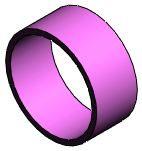Pipe and Tube Parts
|
In pipe and tube parts, each type and size of raw stock is represented by a configuration. In the route sub-assembly, the individual segments are configurations of the pipe or tube part, based on the nominal diameter, the pipe identifier, and the cut length.
Some sample pipe and tube parts are supplied with the software. You can create your own pipe and tube parts by editing the sample part files or creating your own part file. See Routing File Locations for the location of sample parts and for recommendations on where to store new parts you create.
You can also use the Routing Component Wizard in the Routing Library Manager to prepare a part for use in Routing.
|

|
To create a new pipe or tube part:
-
Create a part that meets the geometry requirements for a pipe or tube.
-
Add the configuration-specific property $PRP@Pipe Identifier to the part. This property:
-
Identifies the part as a pipe part, so the software recognizes it when you browse for pipe parts from the Route Properties PropertyManager.
-
Is used as the default name of the local copy of the pipe part when you save the assembly.
-
Must have a unique value for each configuration.
-
Add the configuration-specific property $PRP@Specification to the part (optional). This property can be used with the specification parameter of a connection point to filter pipe and fitting configurations.
-
Insert a design table to create the configurations. In the header row, include the following parameters:
OuterDiameter@PipeSketch
InnerDiameter@PipeSketch
NominalDiameter@FilterSketch
$PRP@Pipe Identifier (value must be unique for each configuration)
$PRP@Specification (recommended)
You can include additional parameters as needed, for properties such as weight per unit of length, cost, part number, and so on.
-
Save the part in the Routing library specified in Routing File Locations.
 Extrude the pipe part in the direction of the positive Z-axis.
Extrude the pipe part in the direction of the positive Z-axis.